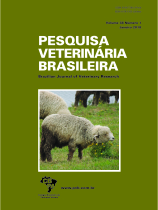 |
|
|
|
Year 2018 - Volume 38, Number 1
|

|
Occurrence of bovine brucellosis and tuberculosis in Rio Grande do Sul, Brazil, based on secondary data, 38(1):15-22
|
ABSTRACT.- Todeschini B., Costa E.F., Santiago-Neto W., Santos D.V., Goff A.C.M., Borba M.R. & Corbellini L.G. 2018. [Occurrence of bovine brucellosis and tuberculosis in Rio Grande do Sul, Brazil, based on secondary data.] Ocorrência de brucelose e tuberculose bovinas no Rio Grande do Sul com base em dados secundários. Pesquisa Veterinária Brasileira 38(1):15-22. Serviço de Saúde Animal, Superintendência Federal do Rio Grande do Sul, Ministério da Agricultura, Pecuária e Abastecimento, Avenida Loureiro da Silva 515/506, Porto Alegre, RS 90010-420, Brazil. E-mail: bernardo.todeschini@agricultura.gov.br
Results of tests for the diagnosis of bovine brucellosis and tuberculosis were evaluated aiming to analyze the distribution of positivity and characteristics of performance of the control program. The analysis used as secondary data the results of all diagnostic tests of bovines executed in 2008 in the state of Rio Grande do Sul (RS) by veterinarians authorized to operate under the National Program for Control and Eradication of Animal Brucellosis and Tuberculosis. The data were statistically adjusted to minimize the effect of outliers and missing data. The tests achieved 66.80% of the 497 municipalities in the RS and included the participation of 165 authorized veterinarians. 40.21% of tests were carried out in the months of April, September and October, and in 73.90% of establishments had tests performed for both diseases. In the case of brucellosis it appeared that 35,289 animals were tested, with positivity of 0.25%, while the frequency of positive holdings among the 3,406 tested was 0.94%. Females had higher positivity rate (0.29% of 26,724 tested) than males (0.13% of 5,235 tested). Animals between 48-60 months of age presented higher chance of positivity compared to other age groups (Odds Ratio (OR) = 2.63; CI 95% = 1.63 - 4.26). Dairy cattle represented 62.66% of tested animals, which were more likely to appear as positive than beef animals (OR = 2.32; CI 95% = 1.38 - 3.90). In addition, 73.74% of the tested holdings were dairy ones. In the case of tuberculosis, 62,149 animals were tested, distributed in 5,151 holdings, with positivity of 0.87% and 3.13%, respectively. The chance of positivity increased with age, being that animals older than 48 months presented higher values compared to those found in younger animals (OR = 2.07; CI 95% = 1.73 - 2.48). Dairy cattle represented 59.74% of tested animals, which were more likely to be positive than beef ones (OR = 5.03; CI 95% = 4.09 - 6.94). Dairy holdings were 78.50% of all the tests for tuberculosis. The comparative analysis of this study with previous studies on brucellosis prevalence suggested that current control measures have been effective in reducing the prevalence of this disease in RS. On the other hand, information obtained on tuberculosis can be indicators of the condition of this disease, especially in the lack of prevalence studies carried out in the last 30 years. Finally, it is concluded that the use of secondary data, if properly adjusted, can be an effective tool in the management of animal health programs and monitoring and surveillance systems.
|
| |
|
|
| |
|
 |